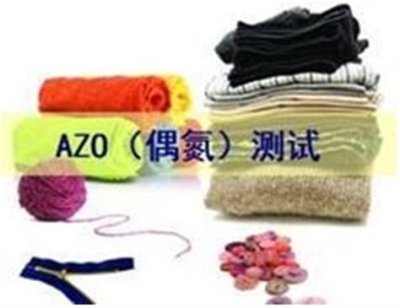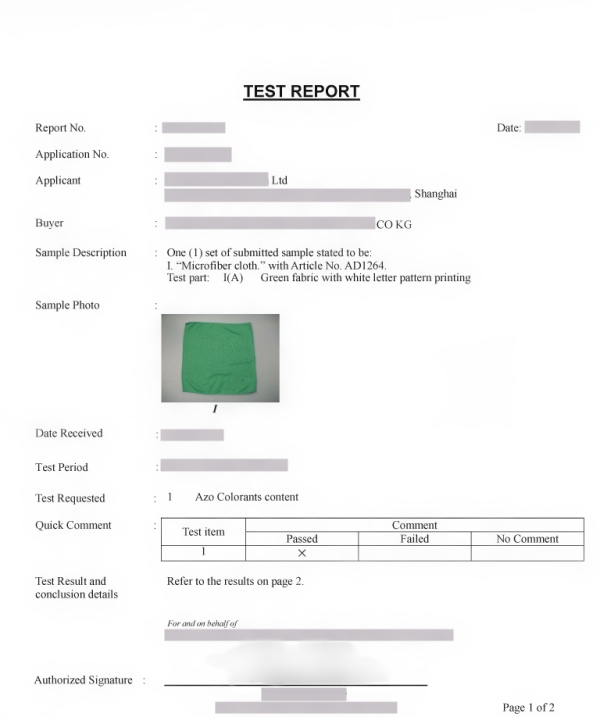AZO返回 Back
Test item 测试名称: AZO 偶氮染料
Norm 标准:EN14362
Test info 测试内容:
| Amines | CAS No. |
| 4-Aminobiphenyl | 92-67-1 |
| Benzidine | 92-87-5 |
| 4-Chloro-o-toluidine | 95-69-2 |
| 2-Naphthylamine | 91-59-8 |
| o-Aminoazotoluene | 97-56-3 |
| 5-nitro-o-toluidine / 2-Amino-4-nitrotoluene | 99-55-8 |
| 4-Chloroaniline | 106-47-8 |
| 4-methoxy-m-phenylenediamine / 2,4-Diaminoanisole | 615-05-4 |
| 4,4'-Diaminodiphenylmethane | 101-77-9 |
| 3,3'-Dichlorobenzidine | 91-94-1 |
| 3,3'-Dimethoxybenzidine | 119-90-4 |
| 3,3'-Dimethybenzidine | 119-93-7 |
| 4,4'-methylenedi-o-toluidine / 3,3'-Dimethyl-4,4'-diaminodiphenylmethane | 838-88-0 |
| p-Cresidine | 120-71-8 |
| 4,4'-Methylene-bis-(2-chloroaniline) | 101-14-4 |
| 4,4'-Oxydianiline | 101-80-4 |
| 4,4'-Thiodianiline | 139-65-1 |
| o-Toluidine | 95-53-4 |
| 4-methyl-m-phenylenediamine / 2,4-Toluylendiamine | 95-80-7 |
| 2,4,5-Trimethylaniline | 137-17-7 |
| O-Anisidine | 90-04-0 |
| 4-aminoazobenzene | 1960-9-3 |
Limit 限量: 每种偶氮键<30ppm
Lead time 测试周期: 常规 regular service 7 working days
Sample size 送样规格: 30g
Others 其他信息:
|
1. New EU Standard of Azo Colorants EN 14362-1:2012 and EN 14362-3:2012 has been Published
EN 14362-1:2012 “Textiles - Methods for determination of certain aromatic amines derived from azo colorants - Part 1: Detection of the use of certain azo colorants accessible with and without extracting the fibres” was published on 31 March 2012. It supersedes the current test standards EN 14362-1: 2003 and EN 14362-2: 2003 and has been effective on 1 September 2012. EN 14362-1:2012 describes a procedure to detect the banned aromatic amines derived from azo colorants in textile fibres, including natural, man-made, regenerated and blended fibres. The standard is relevant for all coloured textiles, e.g. dyed, printed and coated textiles.
Highlights of the New Standard EN 14362-1:2012:
ü All the parts of the textile article that have direct and prolonged contact to skin or mouth have to be analyzed
ü “White” is not considered a color and therefore, white items do not have to be analyzed
ü Composite testing is allowed for up to 3 colors
ü Special instructions in case of very small samples:
· If the mass of a part is < 1 g, multiple parts of the same kind can be tested together as one material
· If the total mass of a material is < 0.2 g, testing of that material is not required
ü Method for extracting colorants is based on the textile composition
ü Additional method for the identification of amines from colorants is provided
ü Optional screening method included
EN 14362-3:2012 “Textiles - Methods for determination of certain aromatic amines derived from azo colorants. Detection of the use of certain azo colorants, which may release 4-aminoazobenzene” was published on 31 July 2012 and will be effective on 31 December 2012.
Azo colorants that are able to form 4-aminoazobenzene, generate under the conditions of EN 14362-1 the amines aniline and 1,4-phenylenediamine. The presence of these 4-aminoazobenzene colorants cannot be reliably ascertained without additional information (e.g. the chemical structure of the colorant used) or without a special procedure. Part 3 of EN 14362 is supplementary to Part 1 and describes a special procedure to detect the use of certain azo colorants in commodities, which may release 4-aminoazobenzene.
|
|
|
|
歐盟公佈偶氮染料新標準EN 14362-1:2012及EN 14362-3:2012
歐洲標準委員會已於2012年3月31日公佈新標準EN 14362-1:2012「紡織品 – 從偶氮染料中釋出的某些芳香胺的測定方法 - 第一部分: 檢測未經抽出纖維或抽出纖維後可接觸到的某些偶氮染料」。新標準已於2012年9月1日正式生效,並取代現行標準 EN 14362-1:2003及EN 14362-2:2003。EN 14362-1:2012是檢測紡織纖維中偶氮染料釋出被禁芳香胺的測定方法,包括天然、人造、再生及混紡纖維。此標準覆蓋所有有顏色的紡織品,例如:染色、印刷及塗層的紡織品。
新標準EN 14362-1:2012的主要重點:
ü 與人體皮膚或口腔有直接或長期直接接觸的紡織品必須進行測試
ü 「白色」不會被當作顏色,因此白色類別的項目不需要進行測試分析
ü 複合測試可容許最多3種顏色
ü 細小部份的特別指令
· 如細小部份的重量少於1克, 同類的部件可當作同一種物料進行測試
· 如該物料的總重量少於0.2克,該物料不需要進行
ü 染料提取的方法是根據紡織品的成份
ü 提供識別染料中的芳香胺的其他方法
ü 包括選擇性的篩檢方法
新標準EN 14362-3:2012「紡織品 – 從偶氮染料中釋出的某些芳香胺的測定方法 - 第三部分: 檢測可釋出4-氨基偶氮苯的某些偶氮染料」已於2012年7月31日公佈,並將於2012年12月31日正式生效。
可形成4-氨基偶氮苯的偶氮染料在EN 14362-1檢測方法的還原條件下,會繼續裂解成苯胺及1,4 - 苯二胺,但在沒有其他輔助資訊 (例如所用染料的化學結構等)或其他特別程序下,不能判斷是否含有4-氨基偶氮苯。EN 14362第3部份是補充第1部份的標準,是用來檢測產品中可能釋放4 - 氨基偶氮苯的某些偶氮染料的特定方法。
|
Sample for reference 参考图片: 




Sample Report 报告样本:



